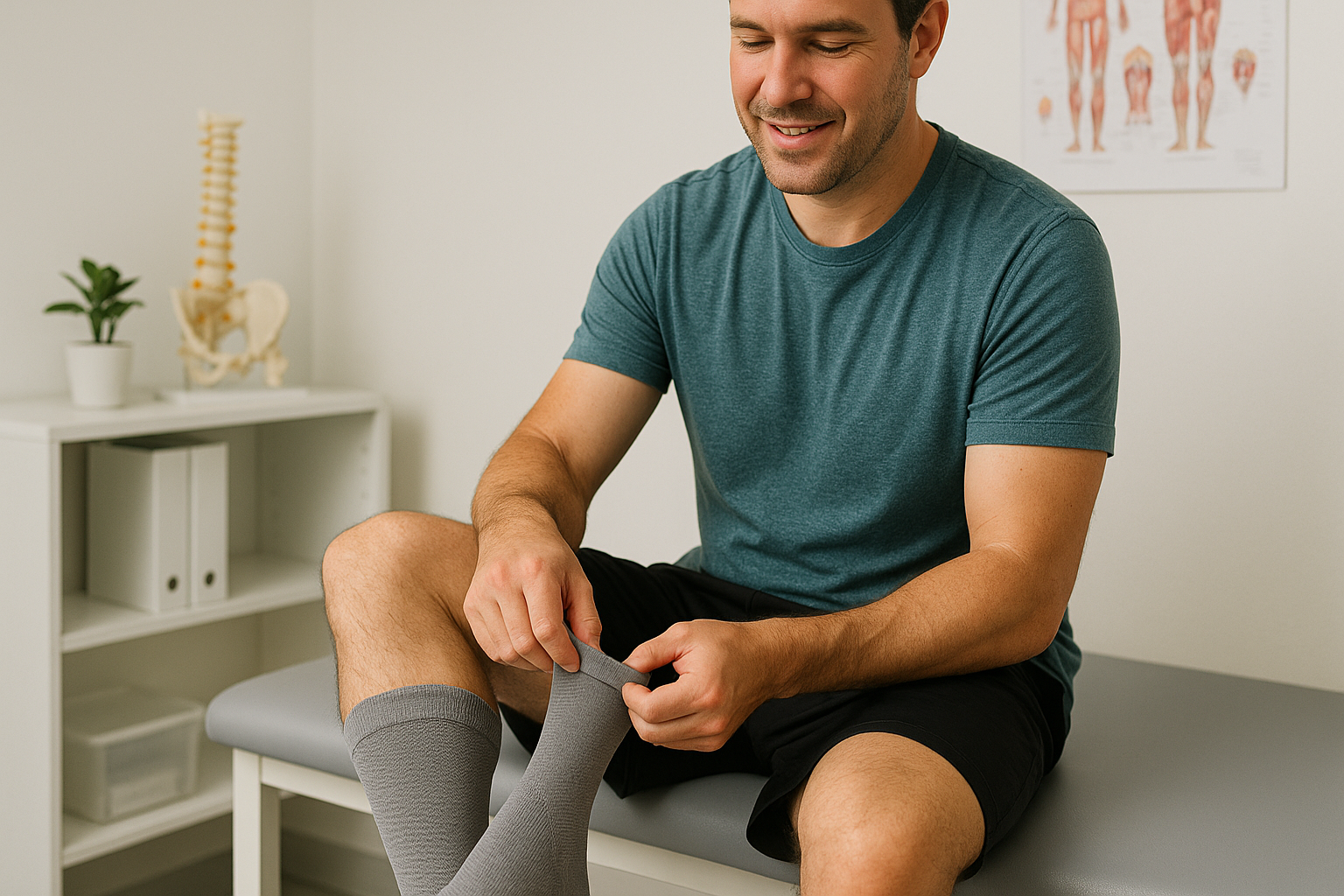What health benefits do orthopedic socks provide?
Orthopedic socks are not just an accessory – they are a therapeutic tool designed to support foot health and overall well-being. Thanks to their specialized design, these socks provide targeted compression, cushioning, and structural support that go beyond what ordinary socks can offer. They are especially valuable for people who suffer from chronic conditions such as diabetes, arthritis, or circulatory disorders, but they can also benefit anyone who spends long hours on their feet. Let’s explore in detail the health benefits that orthopedic socks provide and why they are becoming an essential part of modern foot care.
Improved blood circulation
One of the most important benefits of orthopedic socks is their ability to enhance blood circulation. Many models use graduated compression, meaning the pressure is stronger around the ankle and gradually decreases toward the calf.
This design encourages proper venous return, helping blood flow back to the heart more efficiently. Better circulation reduces the risk of swelling, fatigue, and heaviness in the legs. For individuals with varicose veins, chronic venous insufficiency, or who are prone to blood clots, this feature is particularly valuable.
Even for those without medical conditions, improved circulation helps maintain energy levels throughout the day, especially for people who stand or walk for long hours at work.
Reduced swelling and inflammation
Swelling in the feet and ankles, also known as edema, is a common problem caused by prolonged standing, pregnancy, or medical conditions such as diabetes. Orthopedic socks help minimize fluid buildup by applying gentle compression that prevents excessive swelling.
By reducing inflammation, these socks not only improve comfort but also protect delicate tissues from further strain. This makes them especially helpful for athletes recovering from injuries or patients managing chronic joint conditions.
Pain relief and joint support
Orthopedic socks are also designed to relieve pain and support foot alignment. They often feature reinforced zones around the arch and heel, which provide stability and reduce pressure on sensitive areas.
For people with plantar fasciitis or flat feet, the arch support in orthopedic socks helps reduce strain on ligaments and muscles. Similarly, individuals with arthritis benefit from the warmth and compression, which ease stiffness and make movement less painful.
By supporting natural foot mechanics, these socks act as a preventive measure against long-term issues such as misalignment or repetitive strain injuries.
Protection against injuries and skin complications
People with conditions like diabetes are at higher risk of developing foot ulcers, infections, or skin breakdown due to reduced sensitivity and circulation problems. Orthopedic socks are often made with seamless designs and breathable fabrics to reduce friction and prevent blisters.
Some models are even infused with antimicrobial properties to minimize the risk of infections. By keeping the feet dry, cushioned, and well-supported, orthopedic socks create an environment that protects vulnerable feet from injury.
Enhanced athletic performance and recovery
Orthopedic socks are not just for medical use they are also popular among athletes. The compression and support they provide can enhance performance by increasing oxygen delivery to muscles and reducing fatigue.
During recovery, they help flush out metabolic waste like lactic acid, speeding up muscle repair and reducing soreness. This makes orthopedic socks a valuable tool for runners, cyclists, and fitness enthusiasts who want to optimize both performance and recovery time.
Everyday comfort and fatigue prevention
Finally, one of the most underrated benefits of orthopedic socks is the overall comfort they provide. Their cushioning, breathability, and supportive structure make them ideal for daily wear, especially for professionals who spend hours on their feet, such as nurses, teachers, or retail workers.
By preventing excessive fatigue, they help maintain productivity and improve quality of life. Unlike regular socks, which focus only on covering the feet, orthopedic socks actively work to reduce strain and discomfort over time.
How do orthopedic socks work?
Orthopedic socks may look similar to regular socks at first glance, but their design and functionality go far beyond simple foot covering. They are specifically engineered to provide support, compression, and protection to improve circulation, reduce discomfort, and prevent common foot problems. But how exactly do orthopedic socks work, and what makes them so effective compared to standard socks? Let’s take a closer look at the science and mechanics behind them.
Graduated compression technology
One of the key features of orthopedic socks is their graduated compression. Unlike regular socks, which apply uniform pressure, orthopedic socks exert varying levels of pressure along the leg and foot.
-
The highest pressure is applied at the ankle.
-
The pressure then gradually decreases toward the calf or shin.
This design helps push blood upward against gravity, improving venous return to the heart. As a result, these socks reduce pooling of blood in the feet and ankles, minimize swelling, and decrease the risk of conditions like varicose veins or deep vein thrombosis (DVT).
For people with arthritis, diabetes, or circulation issues, this compression mechanism is a major reason why orthopedic socks are so beneficial.
Enhanced support and stability
Orthopedic socks also work by providing structural support to different areas of the foot. Many models include reinforced zones around the arch, heel, and ankle.
-
Arch support reduces strain on ligaments and muscles, helping individuals with flat feet or plantar fasciitis.
-
Heel cushioning absorbs shock during walking or running, easing pressure on sensitive joints.
-
Ankle stabilization helps reduce the risk of sprains and provides extra comfort for those with arthritis or weak joints.
By stabilizing the foot’s natural alignment, orthopedic socks promote healthier biomechanics and reduce long-term stress on bones and joints.
Temperature and moisture regulation
Another way orthopedic socks work is through their specialized fabrics. These socks are often made from breathable, moisture-wicking materials that keep feet dry and prevent fungal infections or blisters.
Some versions are designed with thermal properties that retain warmth, which is particularly useful for arthritis sufferers who experience stiffness and pain in cold conditions. Warmth improves flexibility and reduces discomfort, allowing for smoother movement.
Reduction of swelling and inflammation
Swelling, or edema, often occurs when fluid builds up in the feet and ankles. Orthopedic socks counteract this problem by applying gentle pressure that prevents excessive fluid retention.
The compression stimulates circulation, encouraging fluid to drain naturally. This makes orthopedic socks especially valuable for pregnant women, people recovering from injuries, or those who spend long hours standing. By controlling swelling, the socks relieve discomfort and help maintain mobility.
Protection against friction and injuries
Unlike traditional socks with bulky seams, orthopedic socks are often designed to be seamless or feature flat seams. This reduces friction against the skin, which is particularly important for people with diabetes, who are prone to developing ulcers or infections from small wounds.
The cushioning in orthopedic socks acts as a barrier against pressure points, preventing calluses, blisters, and other common foot issues. For athletes, this added protection helps reduce the risk of repetitive stress injuries.
Pain management and comfort
Orthopedic socks also work by targeting pain relief. The combination of compression, warmth, and support eases discomfort caused by arthritis, neuropathy, or plantar fasciitis. By improving circulation and keeping muscles and joints supported, these socks reduce stiffness and enhance overall comfort during daily activities.
This pain management effect makes them suitable for both medical use and everyday wear, whether at work, during exercise, or while resting at home.
What conditions can orthopedic socks help with?
Orthopedic socks are more than a comfort accessory – they are a therapeutic tool designed to address specific health issues. By combining compression, cushioning, and anatomical support, they can relieve pain, improve circulation, and prevent complications related to foot and leg health. Whether you suffer from a chronic medical condition or spend long hours on your feet, orthopedic socks can make a significant difference. But what conditions can they actually help with? Let’s explore the main cases where these specialized socks provide real benefits.
Arthritis and joint pain
One of the most common conditions treated with orthopedic socks is arthritis. Arthritis causes joint stiffness, swelling, and pain, often making walking or even standing uncomfortable. Orthopedic socks help by:
-
Applying compression to reduce inflammation.
-
Keeping joints warm, which minimizes stiffness.
-
Providing gentle support to reduce strain on ligaments and tendons.
For people with rheumatoid arthritis or osteoarthritis, these socks can help improve mobility and make daily activities more manageable.
Diabetes and neuropathy
People with diabetes are at high risk of developing foot problems, including neuropathy (nerve damage) and ulcers caused by poor circulation. Orthopedic socks are designed with seamless construction and moisture-wicking fabrics that protect the skin and reduce the risk of blisters or infections.
They also promote better blood flow, which is crucial for diabetic patients who struggle with circulation. By reducing pressure points and maintaining a healthy environment for the feet, orthopedic socks can significantly lower the risk of complications that might otherwise lead to serious infections or even amputation.
Varicose veins and venous insufficiency
Orthopedic socks with graduated compression are highly effective for people suffering from varicose veins or chronic venous insufficiency. These conditions occur when blood pools in the legs, causing swelling, heaviness, and visible, twisted veins.
The compression in orthopedic socks helps push blood back toward the heart, relieving symptoms such as:
-
Swelling in the ankles and calves.
-
A heavy or aching sensation in the legs.
-
Increased risk of blood clots.
Regular use of orthopedic compression socks can improve comfort and slow the progression of venous disorders.
Plantar fasciitis and flat feet
For people with plantar fasciitis or flat feet, orthopedic socks provide crucial arch support. Without proper support, these conditions can cause severe heel pain, inflammation, and long-term strain on the feet and ankles.
The reinforced zones in orthopedic socks help distribute pressure more evenly, reduce stress on the plantar fascia, and provide stability during walking or exercise. They also complement orthotic insoles, enhancing overall foot health.
Edema and swelling
Edema, or swelling of the feet and ankles, can occur due to pregnancy, prolonged standing, or certain medical conditions. Orthopedic socks address this by applying controlled compression that prevents fluid buildup in the tissues.
Pregnant women, for example, often use orthopedic compression socks to relieve swelling and improve comfort during the later stages of pregnancy. Similarly, people who work long shifts standing—such as nurses or retail workers—find relief from fatigue and fluid retention with these socks.
Sports injuries and recovery
Athletes also benefit from orthopedic socks, especially when recovering from injuries like sprains, strains, or overuse syndromes. The socks help by stabilizing joints, improving circulation for faster healing, and reducing post-exercise muscle soreness.
Compression provided by orthopedic socks also flushes out lactic acid more efficiently, speeding up recovery and preventing further injury. This is why they are commonly used by runners, cyclists, and other endurance athletes.
Peripheral artery disease (PAD)
People with peripheral artery disease experience reduced blood flow to their extremities, often resulting in pain, cramping, and cold feet. Orthopedic socks with mild compression can encourage circulation without creating excessive pressure that might worsen the condition.
They help keep the feet warm, promote better oxygen delivery to tissues, and provide an added layer of protection against injury.



How tight should compression gloves be?
How many hours can you wear compression gloves?